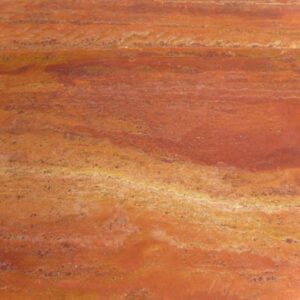Persian Red
Used since the time of the ancient Roman civilization, TRAVERTINO is one of the most widely used marbles in monuments and in ancient and modern buildings. Some examples are the Colosseum and the best known monuments of ancient Rome.
The TRAVERTINO is recognizable by the characteristic holes it has on the surface both in the “counter-pitch” (more frequent) and “pitch” cut and which can be left “open” or filled with cement (also colored) or resin (also transparent) .
In scientific literature it is defined as a fine-grained limestone rock that was formed by the rapid precipitation of calcium carbonate present in an ancient water basin.
TRAVERTINO can be worked in a variety of ways and is therefore a suitable material for both indoor and outdoor use.
The color of TRAVERTINO depends on the oxides it has absorbed during its formation (which happens easily thanks to its rather porous structure). The natural color varies from milky white to walnut, through various shades from yellow to red.
Showing the single result

